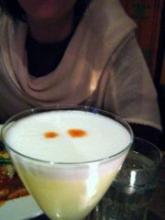The Pisco Sour at Oddfellows in Seattle’s Capitol Hill neighborhood is a beautiful drink. It’s a light, milky yellow color with red Peychaud bitter cutting through the frothy foam top and dribbling in little droplets to the bottom of the glass. It tastes delicious, too—it’s light and effervescent and tastes just a bit like a milkshake, a bit like eggnog.
Which is no surprise. A main ingredient is egg whites.
I couldn’t believe that I was ordering a cocktail made with a raw egg, but it looked so good when the waiter brought it to a nearby table. I thought the only time anyone consumed a raw egg was in large quantities—like body builders on steroids or long distance runners—or people with a death wish, hoping for salmonella poisoning. I was wrong, though, and now I can’t get egg white cocktails out of my head.
Cocktails with egg whites—fizzes, flips and pickups—fell out of fashion in the 1940’s. Now, as nostalgia is in again, especially here in Seattle, egg white cocktails have come back into style along with handlebar mustaches and bowler hats. They are served at most restaurants that want to create old school replicas of Prohibition-era hangouts. In Seattle, some prime examples are Oddfellows, Tavern Law, the Knee-High Stocking company. Last night, I also had another stellar egg white cocktail made with whiskey at the bar at Hunger in Fremont.
There’s nothing old-fashioned tasting about this cocktail. Although some bars use “sour mixes,” the egg white is the original and preferable alternative. Today, bartenders infuse the egg with fruit syrups and add herbs or bitters to the top of their cocktails to make something that uses an old-fashioned idea, but makes the cocktails uniquely modern at the same time.
Although the FDA recommends not handling or eating raw eggs, consumers of egg white cocktails are at very little risk for salmonella poisoning. Plenty of popular dishes used to include raw egg, including meringue, hollandaise sauce, Caesar salad and mousse. The FDA states that only 1 in every 20,000 eggs had salmonella bacteria—compare that to the risk of being struck by drowning which is 1 in 1000. Also, liquors mixed with raw eggs that contain 80-90-or 100 proof alcohol also probably will kill off any festering bacteria. For those planning on using egg whites in their cocktails, most bartenders recommend organic eggs.
Still, for those leery of raw eggs in their alcohol, there are other alternatives that produce similar effects. Pasteurized egg whites come in small cartons and are available at most supermarkets. They require proper refrigeration and still have the potential to be used as salmonella cultures.
Another risk-free alternative is powdered egg whites. They are inexpensive, pasteurized and are easy to store. Egg white producers guarantee that their egg whites are salmonella-free. To use powdered egg whites in cocktails, mix two teaspoons of powder and one ounce of water to create the equivalent of one egg white. Powdered egg white can also be added directly to the drink, but the ratio between liquid and egg white must be the same as in the formula described. Never mix alcohol and powdered egg white together—it produces a hard, plastic-like substance.
Clover Club Cocktail, from The Standard Cocktail Guide by Crosby Gaige,1944.
Ice
1/2 teaspoon sugar
1 1/2 ounces gin 1/2 ounce grenadine (4 dashes)
Juice of 1/2 medium lemon (1 to 2 tablespoons)
1 large raw egg white
Fill a glass two-thirds full with ice. Add the gin, grenadine, lemon juice and raw egg white. Shake to form a good froth. Strain into a martini glass.
Sources and further reading:
http://www.artofdrink.com/ingredients/misc/egg/egg-whites-and-cocktails/
http://www.tablematters.com/index.php/bottle-sections/bz/bz3
